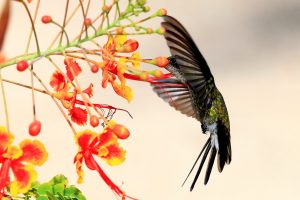Landscaping: Not Just Pretty Flowers Anymore
My front and back yards are a landscaper’s dream. My front lawn is a north-facing patch of dirt dominated by a mulberry tree, while the back is another brown patch dominated by my two dogs. I essentially have blank slates for a creative green thumb to transform into something beautiful and practical.
In fact, landscaping may be my best long-term investment for reducing my home’s heating and cooling costs, protecting me and my family from crime and, if I lived in the East Mountain’s or near a near an open space or forest, from fire.
I’ve got several goals in mind for my yard, not the least of which is water efficiency. There are other considerations, as well: allergy reduction, attracting wildlife like hummingbirds and butterflies, and crime prevention.
Most of us know that certain plants wreak havoc with histamine levels each year, so controlling pollen is a goal for some. As a rule, anything with a pretty flower is pollinated by insects and not by the wind and is friendly to the nose. Most nurseries carry a chart that lists the pollen count of plants so homeowners can pick varieties less likely to aggravate allergies.
 To attract hummingbirds, we’ve got a huge number of options in New Mexico. Your local nursery should have a list or be able to suggest varieties appropriate for your yard’s sun level and your own watering preference.
To attract hummingbirds, we’ve got a huge number of options in New Mexico. Your local nursery should have a list or be able to suggest varieties appropriate for your yard’s sun level and your own watering preference.
Learn how to grow a butterfly garden over at Downtown Homestead
Fighting crime with plants isn’t a new concept, but it is one of the easiest ways to enhance a home. Trim any bushes to below the level of your windows, which will allow neighbors (and police) to see your property and into your house. That way no one can hide behind a bush and break into a window. And keep lower branches of trees trimmed to 6-8 feet from the ground so that someone can’t hide behind it and take you unawares. Rose bushes and pyracantha have lovely thorns, too.
With more and more people moving to forested areas, the need to do as much as possible to protect dwellings from fire danger is growing. The idea of firescaping is to create a defensible zone of at least 30 feet around a home. No stacked wood next to a building, and no coniferous trees within the zone (pines, junipers, cedars, etc.). Within the ‘mid-zone’ (25-30 feet), deciduous trees that drop their leaves in the fall and grasses to hold topsoil create the balance you need. In the summer, their leaves shade your home, while allowing winter light in.
Closer to the house, firescapers can plant smaller groupings of drought resistant plants and shrubs at lest 20 feet apart, complemented by walkways and flagstone. The small groups of plants will be isolated from one another with the goal of preventing the spread of fire from the building to vegetation or vegetation to structure. Using gravel, concrete or flagstone in this area removes fuel entirely.



Comments are closed, but trackbacks and pingbacks are open.